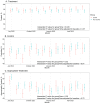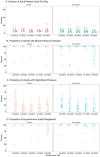Enhancing hypertension education of community health extension workers in Nigeria's federal capital territory: the impact of the extension for community healthcare outcomes model on primary care, a quasi-experimental study
- PMID: 39244554
- PMCID: PMC11380766
- DOI: 10.1186/s12875-024-02579-y
Enhancing hypertension education of community health extension workers in Nigeria's federal capital territory: the impact of the extension for community healthcare outcomes model on primary care, a quasi-experimental study
Abstract
Background: Healthcare workers (HCWs) including community health extension workers (CHEWs) in the Federal Capital Territory, Nigeria participated in a hypertension training series following the Extension for Community Healthcare Outcomes (ECHO) model which leverages technology and a practical peer-to-peer learning framework to virtually train healthcare practitioners. We sought to evaluate the patient-level effects of the hypertension ECHO series.
Methods: HCWs from 12 of 33 eligible primary healthcare centers (PHCs) in the Hypertension Treatment in Nigeria Program (NCT04158154) were selected to participate in a seven-part hypertension ECHO series from August 2022 to April 2023. Concurrent Hypertension Treatment in Nigeria Program patient data were used to evaluate changes in hypertension treatment and control rates, and adherence to Nigeria's hypertension treatment protocol. Outcomes were compared between the 12 PHCs in the ECHO program and the 21 which were not.
Results: Between July 2022 and June 2023, 16,691 PHC visits were documented among 4340 individuals (ECHO: n = 1428 [33%], non-ECHO: n = 2912 [67%]). Patients were on average (SD) 51.5 (12.0) years old, and one-third were male (n = 1372, 32%) with no differences between cohorts in either characteristic (p ≥ 0.05 for both). Blood pressures at enrollment were higher in the ECHO cohort compared to the non-ECHO cohort (systolic p < 0.0001 and diastolic p = 0.0001), and patients were less likely to be treated with multiple medications (p < 0.0001). Treatment rates were similar at baseline (ECHO: 94.0% and Non-ECHO: 94.7%) and increased at a higher rate (interaction p = 0.045) in the ECHO cohort over time. After adjustment for baseline and within site variation, the difference was attenuated (interaction p = 0.37). Over time, control rates increased and medication protocol adherence decreased, with no differences between cohorts. Staffing levels, adult patient visits, and rates of hypertension screening and empanelment were similar between ECHO and non-ECHO cohorts (p ≥ 0.05 for all).
Conclusions: The ECHO series was associated with moderately increased hypertension treatment rates and did not adversely affect staffing or clinical capacity among PHCs in the Federal Capital Territory, Nigeria. These results may be used to inform strategies to support scaling hypertension education among frontline HCWs throughout Nigeria, and use of the ECHO model for CHEWs.
Trial registration: The Hypertension Treatment in Nigeria Program was prospectively registered on November 8, 2019 at www.
Clinicaltrials: gov (NCT04158154; https://clinicaltrials.gov/ct2/show/NCT04158154 ).
Keywords: Education; Hypertension; Implementation; Primary care; Qualitative.
© 2024. The Author(s).
Conflict of interest statement
MDH has received travel support from the World Heart Federation and consulting fees from PwC Switzerland. MDH has an appointment at The George Institute for Global Health, which has a patent, license, and has received investment funding with intent to commercialize fixed-dose combination therapy through its social enterprise business, George Medicines. MDH has pending patents for heart failure polypills. LRH served as a Guest Editor for ‘The role of community health workers in primary care’ Collection.
Figures


References
-
- Vollset SE, Goren E, Yuan CW, Cao J, Smith AE, Hsiao T, et al. Fertility, mortality, migration, and population scenarios for 195 countries and territories from 2017 to 2100: a forecasting analysis for the global burden of Disease Study. Lancet. 2020;396(10258):1285–306. 10.1016/S0140-6736(20)30677-2 - DOI - PMC - PubMed
Publication types
MeSH terms
Substances
Associated data
Grants and funding
LinkOut - more resources
Full Text Sources
Medical
Miscellaneous
